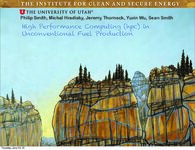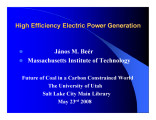TO
| Title | Date | Subject | Description | ||
|---|---|---|---|---|---|
| 1 |
 |
A technical, economic, and legal assessment of North American heavy oil, oil sands, and oil shale resources: In response to Energy Policy Act of 2005 Section 369(p) | 2007-09 | Oil sands; Oil shale; Heavy oil; Energy Policy Act; 2005; Climate Change; Petroleum; Oil Cost; United States; North American heavy oil; Utah Heavy Oil Program; UHOP; World economic development; Energy; Canadian oil sands; Unconventional resources ;Technical; Economic; Legal assessment | Against the backdrop of world population growth, rapid economic expansion in the world's most populous countries, challenging political climates in many oil-producing nations, and the specter of climate change, worldwide energy consumption is projected to increase from the 2004 level of just over 40... |
| 2 |
 |
Phase II: Clean and Secure Energy from Coal: Quarterly Progress Report: January 1, 2011 to March 30, 2011 | 2011-05-01 | domestic coal resources; CO2 capture; coal; Oxycoal simulation team; coal sequestration | The University of Utah is pursuing research to utilize the vast energy stored in our domestic coal resources and to do so in a manner that will capture CO2 from combustion from stationary power generation. The research is organized around the theme of validation and uncertainty quantification throug... |
| 3 |
 |
Phase 2: Clean and secure energy from coal: Quarterly progress report: October 1, 2010 to December 31, 2010 | 2011-01-31 | domestic coal resources; CO2 capture; stationary power generation; LES; DQMOM approach; oxy-coal flames; coal | The University of Utah is pursuing research to utilize the vast energy stored in our domestic coal resources and to do so in a manner that will capture CO2 from combustion from stationary power generation. The research is organized around the theme of validation and uncertainty quantification throug... |
| 4 |
 |
Phase 2: Clean and secure energy from coal: Quarterly progress report: July 1, 2010 to September 30, 2010 | 2010-10-01 | domestic coal resources; CO2 capture; stationary power generation; Oxycoal; OFC; coal | The University of Utah is pursuing research to utilize the vast energy stored in our domestic coal resources and to do so in a manner that will capture CO2 from combustion from stationary power generation. The research is organized around the theme of validation and uncertainty quantification throug... |
| 5 |
 |
Phase 2: Clean and secure energy from coal: Quarterly progress report: April 1, 2010 to June 30, 2010 | 2010-08-01 | domestic coal resources; CO2 capture; stationary power generation; DQMOM approach | The University of Utah is pursuing research to utilize the vast energy stored in our domestic coal resources and to do so in a manner that will capture CO2 from combustion from stationary power generation. The research is organized around the theme of validation and uncertainty quantification throug... |
| 6 |
 |
Gasification studies - Task 4 topical report, Utah Clean Coal Program, Reporting period October 2009 - July 2011 | 2011-10 | Gasification; pressurized entrained-flow coal gasifiers; coal | A key objective of the Task 4 activities has been to develop simulation tools to support development, troubleshooting and optimization of pressurized entrained-flow coal gasifiers. The overall gasifier models (Subtask 4.1) combine submodels for fluid flow (Subtask 4.2) and heat transfer (Subtask 4.3... |
| 7 |
 |
Investigation of coal char-slag transition during oxidation: Effect of temperature and residual carbon | 2009 | coal char; molten slag; bitumous coal; energy and fuels | The transition of coal char to molten slag at high conversion was studied for a bituminous coal using a laminar entrained-flow reactor under oxidizing conditions. Post-oxidized char particles were analyzed by various techniques including loss-on-ignition, gas adsorption analysis and scanning electro... |
| 8 |
 |
Lands with wilderness characteristics, Resource Management Plan constraints, and land exchanges: Cross-jurisdictional management and impacts on unconventional fuel development in Utah's Uinta Basin | 2012-03 | Utah oil shale; oil sands; unconventional fuel resources; land exchanges; land rights | Utah is rich in oil shale and oil sands resources. Chief among the challenges facing prospective unconventional fuel developers is the ability to access these resources. Access is heavily dependent upon land ownership and applicable management requirements. Understanding constraints on resource acce... |
| 9 |
 |
Carbon dioxide sequestration: Effect of the presence of sulfur dioxide on the mineralogical reactions and on the injectivity of CO2+SO2 mixtures | 2010-01 | Carbon dioxide sequestration; CO2; Sequestration stream; Gas injection; CO2+SO2 mixture; Brine; Arkose; Calcite; Anhydrite; Calcium carbonate; CaCO3; Ankerite; Absolute permeabilities; Free-gas; Dissolved gas distribution; Saline formation; Contaminant gases; sulfur dioxide; SO2; Hydrogen sulfide; H... | This report presents experimental and modeling data on certain aspects of carbon dioxide (CO2) sequestration. As different processes are developed and implemented to facilitate the capture of CO2, other contaminant gases (sulfur dioxide, hydrogen sulfide and ammonia) may be present in the sequestrat... |
| 10 |
 |
KTIA corporate introduction | 2009-02-27 | KTIA; KTI; mines | Overview of KTIA's continuing oil sands development activities in Utah, presented at the 2009 Western U.S. Oil Sands Conference by Soung-Joon Kim, Chief Operating Officer, Korea Technology Industry America, Inc. |
| 11 |
 |
Virtual Radiometers for Parallel Architectures | 2012 | parallel architectures; virtual radiometers; a parallel ray tracing scheme; ray tracing algorithms; radiation; ray tracing; monte carlo; combustion; radiometer; parallel | Background: Parallelization of traditional ray tracing algorithms for radiation applications in participating media suffers from the large amount of inter-processor communication required to hand off rays between processors. As a result, strong scaling of these algorithms falls short of the required... |
| 12 |
 |
Federal control of greenhouse gas emissions | 2010-04-28 | greenhouse gas emissions; federal control efforts; domestic legislation | Federal Control Efforts: 1) International 2) New Domestic Legislation 3) Using Existing Domestic Legislation |
| 13 |
 |
Clean and secure energy from domestic oil shale and oil sands resources: Quarterly progress report: October 2009 to December 2009 | 2010-02-03 | ICSE; Clean and Secure Energy program; CASE; Itasca Group; Red Leaf Resources; Enshale's; Vernal, Utah; oxy-fuel; CO2 capture; Oil shale; Oil sands; Crude oil; CO2 emissions; International Flame Research Foundation; Pyrolysis; Lattice Boltzmann; Kerogen; Oil recovery simulation; TGA; Dry shale; Pyro... | The Clean and Secure Energy from Domestic Oil Shale and Oil Sands Resources program is part of the research agenda of the Institute for Clean and Secure Energy (ICSE) at the University of Utah. The program was officially launched on October 1, 2009. The project management plan was submitted for revi... |
| 14 |
 |
Oxy-gas process heaters for efficient CO2 capture | 2010-04-28 | oil shale and oil sands technology; greenhouse gas emissions; GHG; large eddy simulation; LES; IFRF OXYFLAM | Implementation of oil shale/sands technologies in U.S. will require mitigation of greenhouse gas (GHG) emissions. |
| 15 |
 |
Oxy-fuel hierarchy | 2009-11-04 | oxy-fuel combustion; different fuel types; ICSE | Hierarchical chart for the oxy-fuel combustion research area showing connectivity between subtasks. This research area includes coal, gas, and oil oxy-burner technologies. This chart helps illustrate the integration and focus among the different fuel types and different scales represented in the hie... |
| 16 |
 |
In situ production of Utah oil sands | 2008-03-12 | in situ; Utah oil sands; oil sands production; tar sand deposits; Whiterocks eolian sandstone | |
| 17 |
 |
In situ oil shale/sands thermal treatment hierarchy | 2009-11-04 | hierarchial chart; in situ oil shale/sands; thermal treatment research; liquid fuel production; in situ thermal treatment technologies | Hierarchical chart for the in situ oil shale/sands thermal treatment research area showing connectivity between subtasks. This chart helps illustrate the integration and focus among the subtasks needed to achieve liquid fuel production demonstrations of in situ thermal treatment technologies and als... |
| 18 |
 |
GEOMECHANICAL AND FLUID TRANSPORT PROPERTIES | GEOMECHANICAL AND FLUID TRANSPORT PROPERTIES Topical Report | ||
| 19 |
 |
Clean and Secure Energy from Domestic Oil Shale and Oil Sands Resources Quarterly Progress Report | Quarterly report, CASE quarterly report | Clean and Secure Energy from Domestic Oil Shale and Oil Sands Resources Quarterly Progress Report for Project Period: April 2015 to June 2015 | |
| 20 |
 |
P. R. spring oil-impregnated sandstone deposit Uintah and Grand Counties, Utah | 1970-02 | oil-impregnated sandstone beds; oil impregnation; oil shale; lenticular sandstones; siltstones | Oil-impregnated sandstone beds underlie at least 214 square miles in the southeastern Uinta Basin and may extend northward beneath cover. One to as many as five principal saturated zones, 3 to 75 feet thick, occur in a 250-foot interval that dips gently northward. The northernmost outcrops are overl... |
| 21 |
 |
Hydrotreating the Whiterocks oil sand bitumen and bitumen-derived liquid (Abstract only) | 1992-12 | hydrotreating; Whiterocks oil; oil sand; bitumen; bitumen-derived liquid; bitumen conversion; heteroatom reduction; heteroatom | Conversion of Utah's Uinta Basin bitumens to liquid fuels requires molecular weight reduction of the parent material as well as removal of heteroatoms. Heteroatom reduction of bitumen obtained through solvent extraction of Whiterocks oil sand was investigated. A comparison of the relative processabi... |
| 22 |
 |
High performance computing (hpc) in unconventional fuel production | 2013-05-07 | ICSE; Unconventional fuels; High performance computing; unconventional fuel production | Presentation given at the University of Utah Unconventional Fuels Conference, Salt Lake City, Utah, May 7, 2013. |
| 23 |
 |
Phase 2: Clean and secure energy from coal: Quarterly progress report: October 1, 2009 to December 31, 2009 | 2010-01-30 | domestic coal resources; CO2 capture; stationary power generation; oxy-coal flames; coal gasification process | The University of Utah is pursuing research to utilize the vast energy stored in our domestic coal resources and to do so in a manner that will capture CO2 from combustion from stationary power generation. The research is organized around the theme of validation and uncertainty quantification throug... |
| 24 |
 |
Evaluating opportunities for reducing life-cycle, well-to pump GHG emissions from conventional and unconventional fuels | 2010-04-28 | unconventional fuels; GHG emissions; conventional fuels; reducing life-cycle; oil shale; oil sands; coal | Resource extraction and upgrading. |
| 25 |
 |
High efficiency electrical generation | 2008-05-23 | efficiency of electrical generation; electrical generation; fossil fuel energy resources; mitigatint GHG emissions; CO2 capture and sequestration | Outline: 1-Electricity outlook and fossil fuel energy resources. 2-Technology options for mitigating GHG emissions. 3-CO2 cpature and sequestration. 4-Costs. 5-Concluding remarks. |
